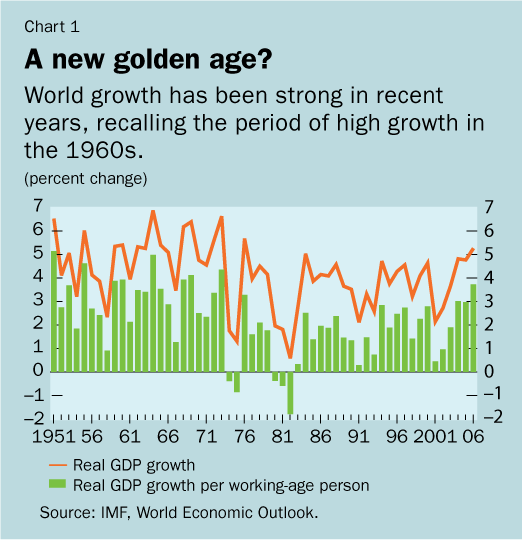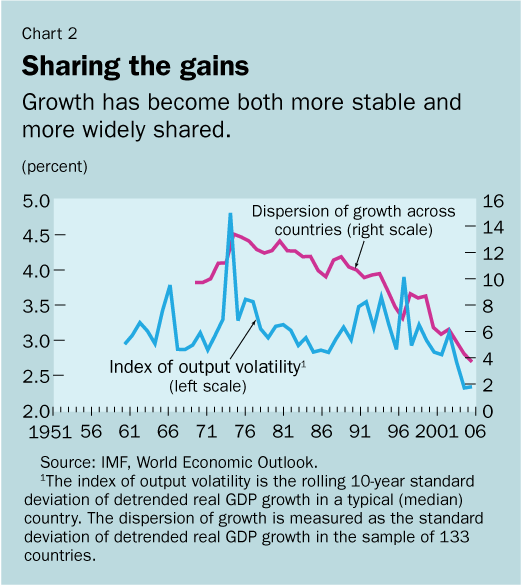
Typical street scene in Santa Ana, El Salvador. (Photo: iStock)
IMF Survey: How to Lock In Global Growth
October 10, 2007
- Volatility of world output has fallen progressively since 1970s peak
- Advanced economies improved stability, experienced long expansions
- Output stabilization in developing countries was more gradual, modest
During 2004-2006, the world economy enjoyed its most rapid growth since the late 1960s and early 1970s.

Process of trade and financial globalization has generated new risks, vulnerabilities, World Economic Outlook finds (photo: Sean Yong/Reuters)
POLICY IMPROVEMENTS BRING STABILITY
Global output has on average increased by 4.9 percent per year (see Chart 1). After controlling for increases in the working-age population, world growth has been 3.2 percent—only slightly lower than during the 1960s.
Key points
The background: From 2004 to the present, world growth has been much more rapid than at any time since the early 1970s. This growth has been shared across countries to an unprecedented degree. Moreover, output volatility in most countries and regions has declined significantly.
Analysis: Reduced output volatility and the associated lengthening of economic expansions largely reflect sources that are likely to prove persistent, rather than mere good luck. In particular, improvements in the conduct of monetary and fiscal policy, as well as in broader institutional quality, are all expected to keep output volatility low going forward.
Policy implications: That said, lower volatility does not rule out occasional recessions. The abrupt end to the period of strong and stable growth in the 1960s and early 1970s and the Asian crises of the 1990s provide cautionary tales of what can happen if policymakers do not respond appropriately to new risks and challenges.
Not only has recent global growth been high but the volatility of world output has also fallen progressively since its 1970s peak, even though potentially more volatile emerging market and developing countries account for a rising share of the global economy.
A chapter in the latest World Economic Outlook, entitled "The Changing Dynamics of the Global Business Cycle," takes stock of what we know about changes over the past few decades in output volatility and in the resilience of expansions, together with their underlying causes.
The research, which covers a broad sample of regions and countries, focused on determining to what extent policy actions have helped bring about a lasting reduction in volatility, thereby making expansions last longer.
A new golden age?
In important ways, the global economy has recently displayed greater stability than observed even in the 1960s—the last golden age of strong and stable growth.

In particular, the volatility of output has decreased in most countries, with the typical country experiencing a one-third decline between the 1960s and the present (see Chart 2).
Growth is also more broadly shared across countries than previously observed. For example, average growth exceeded 4 percent in two-thirds of countries during 2003-06, and was less than 1 percent in only one out of twenty countries. In other words, virtually all countries have been doing well.

Advanced economies in particular improved their stability, and typically experienced long expansions, after the 1970s and the disinflation of the early 1980s. Indeed, the share of time that advanced economies spent in a recession halved to a mere 8 percent between 1947-82 and 1983-2006, and there have been almost no deep recessions.
Output stabilization in developing countries was more gradual and modest. Until the beginning of this decade they often experienced deep and sometimes recurrent crises, including debt crises (especially in Latin America and Africa) and banking and currency crises (in Asia, Central and Eastern Europe, and Latin America).
Some countries also experienced high volatility during their transition from centrally planning to market economies. Overall, output volatility in developing economies on average remains more than twice as high as in advanced economies.
Institutional change
Our analysis suggests that the strong durability of expansions and low output volatility largely reflect sources that are likely to prove permanent. In particular, better monetary policy may explain about one-third of the total stabilization of output fluctuations over time. More stable fiscal policy (in advanced economies) as well as trade liberalization and broad institutional improvements (in developing economies) also helped.
It is also worth noting that the decline in world output volatility between the 1960s and the present largely reflects lower volatility of consumption rather than of investment. This suggests that any explanations for the recent stability need to include factors that affect consumer behavior, such as the rising availability of financing to smooth consumption over time. Reductions in terms-of-trade volatility (possibly representing only temporary "good luck") have played an important, but not dominant, role in lowering output volatility—about one-eighth of the total.
In a similar vein, our analysis found that lower volatility and longer expansions in advanced than developing economies in large part reflect more stable monetary and fiscal policies in the advanced economies. Part of the remaining difference reflects the generally stronger institutions in advanced economies, which have resulted in greater political stability and continuity in policy-making. Greater terms-of-trade volatility in developing economies, as well as structural differences (such as the greater weight of agriculture and commodity-related sectors), play a smaller role than is often assumed.
Risks have not gone away
Despite these improvements, future stability should not be taken for granted. Low average volatility does not rule out occasional recessions. The process of trade and financial globalization has generated new risks and vulnerabilities. For instance, losses associated with highly leveraged investments in the U.S. subprime mortgages market have created distress in the banking sector in many advanced economies, raising concerns about a possible global credit crunch.
Even looking beyond the recent turmoil in global financial markets, significant potential risks arise from global current account imbalances, as well as from the linkages between monetary and prudential policies and sustained asset price booms. All this provides a reminder that the task of maintaining expansions requires policymakers to continuously identify and adapt to new risks and challenges in the global economic system.


